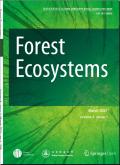Developing and evaluating satellite-derived phenology and physiology indicators for modeling annual gross primary productivity variability
IF 4.4
1区 农林科学
Q1 FORESTRY
引用次数: 0
Abstract
Vegetation annual gross primary production (AGPP), the total yearly carbon assimilation via photosynthesis, serves as a key indicator of ecosystem carbon uptake. While AGPP variations are jointly influenced by both vegetation phenology and physiology, the effectiveness of satellite-derived indicators in capturing these variations has not been fully evaluated. This study develops and evaluates the satellite-derived phenology and physiology indicators for modeling AGPP variability. We assessed the performance of satellite-derived metrics, including solar-induced chlorophyll fluorescence (SIF), leaf area index (LAI), and enhanced vegetation index (EVI), in capturing AGPP variations. Among these, SIF-based indicators exhibited the highest accuracy (Pearson's r = 0.79; root mean square error = 414.7 gC·m−2·year−1), outperforming LAI- and EVI-based indicators. To further investigate the mechanisms driving AGPP variability, we used a structural equation model based on in situ observations to quantify the direct and indirect effects of climate on AGPP through phenology and physiology. Our results reveal that vegetation physiology, particularly the seasonal maximum gross primary production, plays a more dominant role in regulating AGPP than phenology. Furthermore, we found that globally, SIF-derived phenology indicators tend to be lower than those from LAI and EVI, whereas SIF-derived physiology indicators are elevated in tropical regions and the Southern Hemisphere. These findings highlight the potential of satellite-derived indicators in advancing AGPP modeling and emphasize the predominant role of vegetation physiology in regulating ecosystem carbon uptake. This study contributes to a refined understanding of global carbon cycle dynamics and provides insights for improving large-scale carbon assessments in the context of climate change.

开发和评估卫星衍生物候和生理指标,以模拟年度总初级生产力变异
植被年总初级生产量(AGPP)是生态系统碳吸收的一个重要指标。虽然AGPP变化受到植被物候和生理的共同影响,但卫星衍生指标在捕捉这些变化方面的有效性尚未得到充分评估。本研究开发并评估了卫星衍生的物候和生理指标,用于模拟AGPP变异性。我们评估了卫星衍生指标的性能,包括太阳诱导的叶绿素荧光(SIF)、叶面积指数(LAI)和增强植被指数(EVI),以捕获AGPP变化。其中,基于sif的指标具有最高的准确性(Pearson’s r = 0.79,均方根误差= 414.7 gC·m−2·year−1),优于基于LAI和evi的指标。为了进一步研究AGPP变化的驱动机制,我们采用基于原位观测的结构方程模型,通过物候和生理学量化气候对AGPP的直接和间接影响。结果表明,植被生理,尤其是季节最大初级生产总量对AGPP的调节作用大于物候。此外,我们发现,在全球范围内,sif衍生物候指标往往低于LAI和EVI,而sif衍生生理指标在热带地区和南半球较高。这些发现突出了卫星衍生指标在推进AGPP建模方面的潜力,并强调了植被生理学在调节生态系统碳吸收方面的主导作用。该研究有助于对全球碳循环动态的精细化理解,并为改善气候变化背景下的大规模碳评估提供见解。
本文章由计算机程序翻译,如有差异,请以英文原文为准。
求助全文
约1分钟内获得全文
求助全文
来源期刊

Forest Ecosystems
Environmental Science-Nature and Landscape Conservation
CiteScore
7.10
自引率
4.90%
发文量
1115
审稿时长
22 days
期刊介绍:
Forest Ecosystems is an open access, peer-reviewed journal publishing scientific communications from any discipline that can provide interesting contributions about the structure and dynamics of "natural" and "domesticated" forest ecosystems, and their services to people. The journal welcomes innovative science as well as application oriented work that will enhance understanding of woody plant communities. Very specific studies are welcome if they are part of a thematic series that provides some holistic perspective that is of general interest.
 求助内容:
求助内容: 应助结果提醒方式:
应助结果提醒方式:


